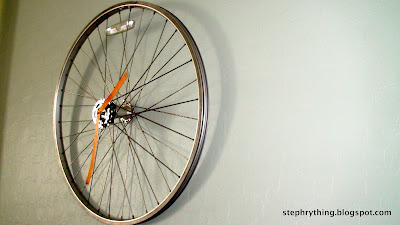Last fall while watching the pilot episode of the new Design on a Dime with Casey Noble on HGTV, I saw the designers create a clock out of a bike wheel. I thought it was so neat that I had to try it.
Months later, after hours of fruitless searching for the episode online, or any other tutorials, I almost gave up.
But then I decided, why the heck not?
I set off to find a guinea pig wheel or bike. I struck out at several thrift stores. But then I was directed to Southwest Bikes and I tried my luck. After explaining my idea to them, I asked if they had any junk wheels I could buy. As fate would have it, they did!
 |
| Please forgive me for using a few stock photos. |
Then I bought a clock kit from a craft store, similar to this one. I toyed around with the idea of buying a clock and taking it apart, but that sounded waaay out of my skill level. Or patience.
I took my treasures home and spent the next few days brainstorming and trying to disassemble the wheel. After several unsuccessful attempts, despite the youtube videos that said I could do it without special tools, I turned to professional help.
The awesome guys at Broken Spoke Bikes endured several visits from me (one where I accidentally left the bike wheel in the parking lot, they held it for me til I returned). They graciously took apart the bike cassette and sawed down the hub so the wheel could sit flush against the wall.
Then I was left with an empty skeleton of a bike wheel. I scrubbed it and the cassette parts with oven cleaner and steel wool til they shined.
I could finally begin turning it into a clock.
And since I was so wrapped up in the project, I failed to take tutorial pictures. But here's how I did it.
Total cost: Free wheel + $12 clock kit + free handy help + glue and paper on hand = $12 and DIY labor
- I dry fitted the clock parts with a few smaller sections (gears) from the bike cassette. According to my husband, some wheels' cassettes come completely apart, some are completely stuck together, and some come in several chunks. Note this when looking for a wheel. I lucked out. I sandwiched the gears in between the clock motor and the clock hands, making sure the hands had plenty of clearance to spin around. Measure twice, cut glue once, right? I carefully glued the gears to the front of the clock motor using E6000/super glue, waiting plenty of time for it to dry.
- I dry fitted the clock motor onto the middle of the wheel, looking underneath it to make sure where I would be gluing wouldn't keep me from changing the battery or changing the time on the back of the clock. I also decided I wanted the top or "12" on the clock to be where the reflector was, so I positioned the motor accordingly. Then I carefully glued the motor to the wheel.
- For the clock hands, I wanted something bigger and brighter than how the kit came. But I had to find something that wouldn't weigh down the hands or else they wouldn't function correctly. Cue scrapbook paper. Yep, I cut out four skinny rectangles, two of each size for hour/minute hands, and glued them together with the clock hands sandwiched in the middle on one end -- poking a big enough hole through the paper so the hand could attach to the clock motor. I decided to leave off the second hand. Seemed appropriate.
- I attached the clock hands to the motor, per the clock's instructions, and stepped back to look at my master{time}piece.
And then I gave it to my husband's boss, an avid cyclist. Now I want one, too.






4 comments:
OMG that is SO awesome! Wow...what a great original idea. New to your blog :) -Melissa
I want one too ... and thanks for the great tutorial! Now I'm motivated to make one of my very own. And I like the idea of visiting a bike shop for a wheel. I have one around the corner from my home so I'll be visiting soon ...
:)
Linda
Hi, how did you attach the clock to the wall?
Are you still able to change the batteries?
Post a Comment